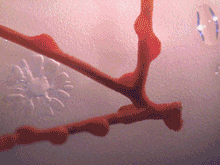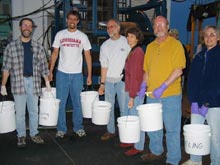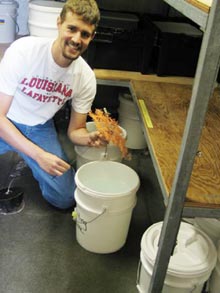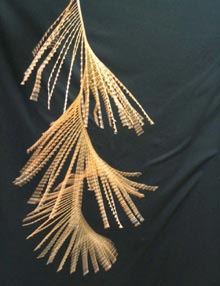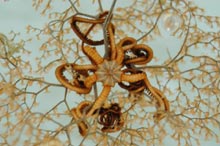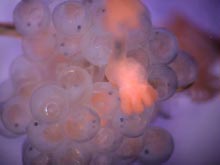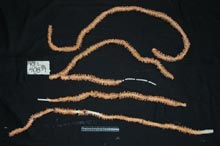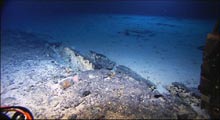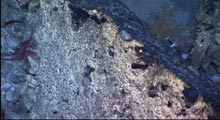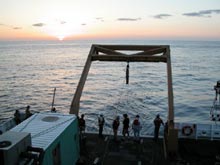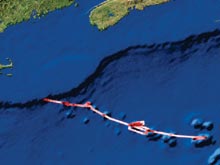View the slide show of some of the first images taken on Kelvin Seamount. ![]() Click image to view a slide show.
Click image to view a slide show.
Success!
May 19, 2004
Mary Grady
Adjunct Earth Science Instructor
Northeastern University
Diana Payne
Biologist and Education Coordinator Connecticut Sea Grant
He who venturously brings up from the abyss enough of its inhabitants . . . will taste that cup of delight, the sweetness of whose draught only those who have made a discovery know.
—E. Forbes, 1859
After a night of rocking and rolling on the waves, while a low pressure system drifted past, Tuesday morning dawned calm and clear. The remotely operated vehicle (ROV) crew had finished their repairs, got a good night's sleep, and were ready to send the vehicles back into the sea—though not quite as deep as the day before. Hercules dove to about 1800 m and worked all afternoon, taking video and gathering samples, with no mechanical problems at all.
White plastic buckets play a recurring role in this kind of field work. As Hercules is being winched toward the surface, the science team begins a bucket brigade. The formula: one big five-gallon white plastic bucket for each sample. The team carries buckets, filled with cold seawater, out from the big walk-in freezer to the aft deck. As soon as Hercules is secured on deck and the bio box is opened, scientists gently place each sample into its own personal bucket, give it a label, and rush the bucket back into the cold room. One by one the buckets are brought into the bio lab and emptied of their specimens. The water is dumped into the bio lab sink—but not without running the contents through a sieve, to be sure any fragments from the deep get a close look. Finally, the buckets are refilled with cold seawater, and kept in the cold room for samples from the next dive.
(From left) Dr. Scott France, Mercer Brugler, Dr. Jon Moore, Dr. Lauren Mullineaux, Lance Arnold, and Susan Mills—ready-and-waiting members of the bucket brigade. Click image for larger view.
The bucket brigade is just one example of how the science team, comprised of scientists and students from a half-dozen institutions, work together. During dives and microscope sessions, they gather around the video screens and share observations, insights, and information. Like any group in the field, they inject a lot of humor into their interactions. It's not all serious scientific conversation, but a lot of joking and laughter and having fun together, as they share in the excitement of discovery.
A mass of unidentified fish eggs on Metallogorgia collected at Kelvin Seamount. Click image for larger view.
Last night, at about 7:30 pm, just as a brilliant sunset was reddening the clouds on the horizon, the ROVs were brought back on deck. The bucket brigade dove in to get their samples into the lab. Right away, Susan Mills got a Metallogorgia under the video microscope and showed on screen a tiny bunch of fish eggs attached to its branches. "If these eggs are from a managed species," Dr. Peter Auster said, "and they need the coral to reproduce . . ." It was understood that this would help in arguing for the protection of the coral species; however, the chances of those eggs being from a commercial species in this part of the ocean are remote. Dr. Jon Moore, who is an expert in fishes, took an egg sample to determine exactly what kind of fish laid them.
Interesting geological structure—possibly carbonate, with manganese crust. Click image for larger view.
By about 9 pm, the vehicles were back in the water and heading down to a new site at about 2,200-m depth. It was a clear, brilliant night, and graduate student Anne Simpson took advantage of the calm seas to spend a night on the bow. "I wrapped up in my sleeping bag, and just watched the stars, and saw the sun come up," she said. "It was great to watch the constellations. The Milky Way was on the horizon when I went out there, then moved higher and higher in the sky." Sunrise was early, since we are so far east, but running on ship time, which remains in sync with the East Coast. "The sun was coming up about 4 am," Anne said.
All night long, the ROVs stayed underwater, exploring the rocky ridges of Kelvin Seamount. The terrain was spectacular, with steep rock walls and lots of ridges, with swift currents that challenged the talented ROV pilots. We found three-foot-tall trumpet sponges and collected a lovely spiraling Iridigorgia coral. The ROV team also developed a precise measuring protocol to determine the lengths of some of the long bamboo whip corals we have seen at many sites so far.
Wednesday afternoon, the education crew completed their third live Webcast on www.explorethesea.com ![]() , with Dr. Les Watling providing live voice-over as Hercules roved along a rocky ridge. During the Webcast, a pre-taped segment showed IFE's Jim Newman giving a guided tour of the two vehicles. Watch www.explorethesea.com at 1:30 pm Thursday and 1 pm Friday for the next two educational Webcasts. Live video from Hercules is streaming over the site between 9 am and 9 pm through the weekend.
, with Dr. Les Watling providing live voice-over as Hercules roved along a rocky ridge. During the Webcast, a pre-taped segment showed IFE's Jim Newman giving a guided tour of the two vehicles. Watch www.explorethesea.com at 1:30 pm Thursday and 1 pm Friday for the next two educational Webcasts. Live video from Hercules is streaming over the site between 9 am and 9 pm through the weekend.
Hercules explored the seamount all day Wednesday, then came on board briefly about 6 pm. While the ROV crew checked the vehicles and prepared them for their next dive, the Ronald H. Brown crew repositioned the ship to another part of Kelvin.
Mountains in the Sea 2004 Course
Allan Gontz
Graduate Student
University of Maine
The map on this page shows our course from the time we left the continental shelf at George's Bank until our most recent dive on Kelvin Seamount. It was created by extracting the center beam of the SeaBeam 2112 multibeam sonar system. The colors are coded to represent depths. Unlike normal bathymetric representations, here, the darker colors are shallower. This highlights the peaks of the seamounts. Depths over seamount summits are typically between 1500 and 1700 m, while the intervening sea floor exceeds 5000 m in places. The darker red spots from left to right are: (1) edge of the continental shelf, (2) Bear Seamount, (3) Physalia Seamount, (4) Retriever Seamount, (5) Balanus Seamount, (6) Kelvin Seamount, (7) Atlantis Seamount, (8) Gosnold Seamount complex, (9) Manning Seamount complex. Our scientific explorations will visit Bear, Balanus, Kelvin, and Manning seamounts. Cape Cod, Mass., Yarmouth, Nova Scotia and Walpole, Maine (home of chief scientist Les Watling) are all visible on the far left.
Sign up for the Ocean Explorer E-mail Update List.






















